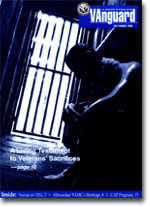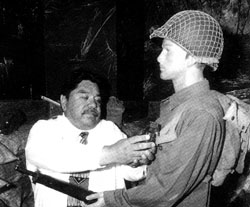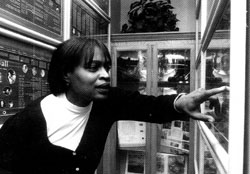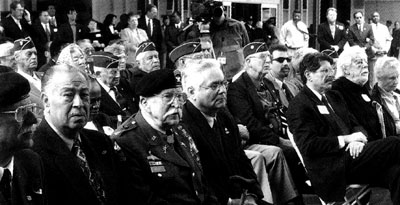
Lessons In Liberty
VAnguard - July 2002 - By Matt Bristol
This article was featured in VAnguard. The Los Angeles VA Regional Office has undergone a major facelift. Visitors say everything has changed except the street address. When Director Stewart Liff arrived in 1994, Los Angeles ranked the worst of VA's 58 regional offices when it came to customer satisfaction. Today, it is well above the national average.
"This was a place where, far too often, veterans' claims were denied, resulting in unnecessary appeals, remands and rework," explained Liff, who began his VA career in 1978. "Today, it is a living testament to their sacrifice." The entire seven floors of the regional office have been transformed into a veterans museum. In the process, the organizational culture has shifted; employees now focus on granting benefits when they can, denying only if they must.
On May 20, the office celebrated its new attitude with a grand reopening ceremony. Secretary Anthony J. Principi flew in for the celebration and took a tour of the office and its new museum.
His first stop was the "War Room," a regular meeting spot for top-level managers. Inside, Beckie Lubow, a management analyst, had just finished updating the performance reports, bar charts and line graphs covering the walls. The charts measure everything from the number of veterans rehabilitated to the number of claims granted. "What I'm most proud of is this," Liff told the Secretary, pointing to a customer satisfaction chart.
Walking down the hallway, he stopped to show the Secretary photos of how the place used to look in the early 1990s. The photos revealed a gloomy, dark place with duct-taped carpets, nicotine-yellow walls and rows of government-issue file cabinets.
The drab photos are in sharp contrast to the brightly lit employee conference room across the hall. The room is literally dedicated to the employees. There are large color photos of new employees, pictures of employees while they were in the military, and shots of employees posing with their families.
The veterans museum isn't centrally located, but spread throughout the towering federal building which houses the regional office. In the lobby of each VA floor, there are personal reflection areas like the 3-D hologram display outside the Veterans Service Center.
Stepping off the elevator, visitors are greeted by holograms of southern California veterans describing their wartime experiences. In one segment, Harry Corre describes his experience escaping from the Bataan Death March. He fled from his captors one night and used driftwood to navigate the shark-infested waters off Corregidor. One month later, he was recaptured by the Japanese and eventually sent to Japan, where he was forced to work in a coal mine and witnessed the bombing of Nagasaki. "I'm still frightened to go into a room that is not lit up and I constantly wake up thinking I am in a cave-in," explained Corre, who was twice buried alive while working in the mines.
There are display cases showing photos, patches, and other wartime memorabilia, including the artwork of Doyle Lott, a World War II pilot who was shot down over Europe. While held prisoner of war, he made a paintbrush from human hair and painted scenes of his aircraft plummeting into the sea.
Another case holds items left at the Vietnam Veterans Memorial in Washington, D.C. There is a photo of a smiling middle-aged couple with three young girls. An accompanying note read: "On the 34th anniversary of your death, I miss you John. Even after so many years. This is me and my husband and my three daughters. You guys would have had lots of fun."
These stories are real, they're personal, and they carry a powerful message. "I think a lot of the younger people now feel a stronger connection with our mission," observed Larry Fillipo, a senior management analyst who doubles as the museum's curator. "They see the photos, they meet the veterans…it's had a tremendous impact."
Sherry A. Maxwell feels that connection. Prior to joining VA about a year and a half ago, the human resources specialist hadn't had much exposure to the military or veterans. Today, she's leading veterans as they tour the museum. "This is my favorite place," she said, stopping on the 4th floor beside "The Living Wall," a replica of the Vietnam Veterans Memorial where visitors can search for names on the Wall while listening to audio recordings of veterans' wartime experiences. "Seeing all those names, I think about what they must have gone through and for their families," said Maxwell. "What they did for our country, nobody should disrespect that."
As powerful as it is, the museum is just one aspect of the visual management approach embraced by Liff, who holds a bachelor's and master's degree in fine arts. His style involves a "whole brain" approach to communication. It works like this: visual images stimulate the right side of the brain, the creative side, while data and figures spark the brain's logical left side.
The goal is to create a sense of purpose, to re-energize the employee's focus. "I believe in rallying the troops around our mission," explained Liff. "Nobody is going to pay attention to vision statements, strategic plans, and balanced scorecards if they're not focused on the mission." For Liff, it all comes back to creating a positive organizational culture and building a sense of pride among employees.
Frank Flores feels that sense of pride. The decision review officer and retired Air Force master sergeant has been at the Los Angeles office for 12 years. "I'm proud to say that this station has one of the best cadres of decision review officers and ratings specialists," he said, while walking past Core Group 1, a group of compensation and pension claim raters.
On a maroon file cabinet next to their work area stood a sign showing the group's scorecard - nine out of a possible ten. Above, hanging from the ceiling, are banners reminding employees to "Grant When You Can." Flanking the banners are large color photos of employees wearing their military uniforms. The focus clearly on veterans, but it wasn't always that way.
Rick Brandenburg remembers when VA employees used to show up for work in shorts and T-shirts. The combat-injured Army veteran has worked in the building since 1978 and serves today as district manager in the Division of Veterans Services for the California Department of Veterans Affairs. He's recognized the recent changes and offered his perspective. "The quality of work here has improved tremendously," he said. "There are much less remands because our people are doing a better job the first time…it says a lot about the kind of people you've got working here."
After touring the museum, Secretary Principi and Director Liff went out to the courtyard where about 200 veterans and their families, local congressional representatives, and other dignitaries huddled beneath the awning as a rare rainstorm hit Los Angeles. Among those gathered were a dozen former POWs and two Medal of Honor recipients, including former regional office employee Walt Ehlers, who led a squad on Utah Beach during the Normandy invasion in World War II, and Lewis L. Millet, who served in World War II, Korea and Vietnam. Some credit Millet with being the most decorated living war veteran.
While addressing the audience, Secretary Principi singled out former POW Lott, whose paintings were on display inside. "Mr. Lott, let me assure you that I would not trade your paintings for any of the works in the world-famous Getty Museum," he said. He also offered his thoughts on the office's 180-degree turnaround. "Welcome veterans, honor them for their service, and grant their requests for benefits when you can. That has to be a winning formula. That's the spirit evoked by the displays and exhibits in this office, and that's what I want to see in every VA office from Manila to Maine."
The museum was funded through donations from veterans service organizations and is open to the public. For more information, visit the regional office web site at www.valaro.com.




